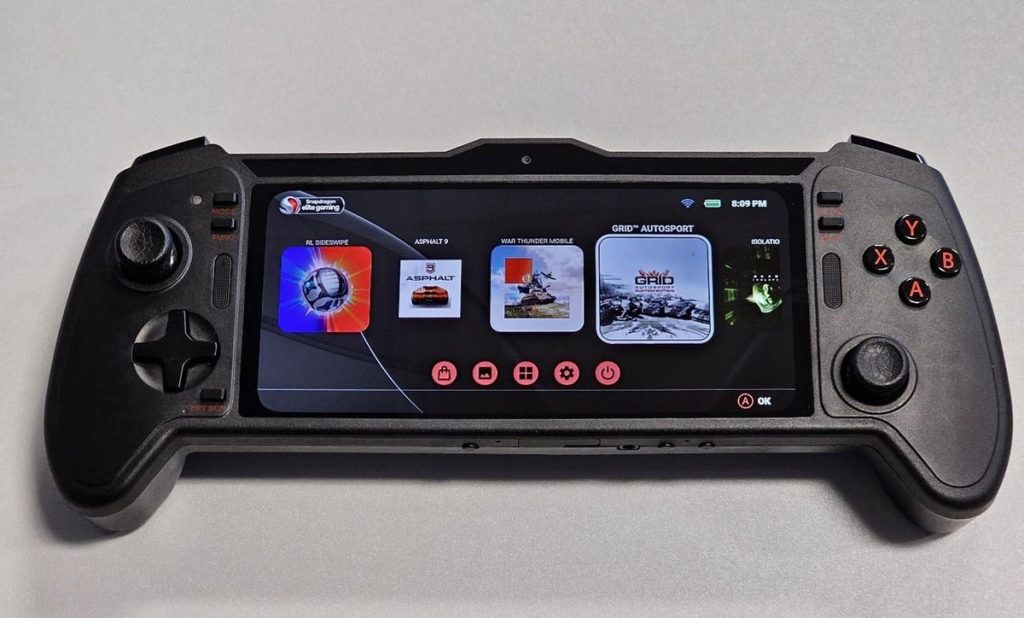In the past couple of weeks, Qualcomm announced its new lineup of chips for handheld gaming devices. Building on the success of its first-generation Snapdragon G3x chip, Qualcomm looks poised to redefine the high end of this niche while also offering something for everyone with three tiers of products.
Qualcomm entered the handheld gaming market almost two years ago with its Snapdragon G3x Gen 1 chip, which eventually powered the Razer Edge 5G gaming handheld. This device and chip were among the first of their kind to offer a high-end Android gaming experience—one that was simply not possible with previous smartphone-based designs that lacked adequate cooling and battery life. Since then, we’ve seen the handheld gaming market grow, with subsegments that have evolved to the point that the market cannot be served by a single chipset.
With the original Snapdragon G series launch, Qualcomm stated that it would eventually expand the series into multiple tiers. Now it’s making good on that promise, and we get not only a new high-end Snapdragon G chip, but also corresponding designs for two lower tiers. I expectat that all of these chips will find homes in consumer devices next year, so we can consider this announcement a bit of a preview for what’s to come.
Snapdragon G3x Gen 2
The Snapdragon G3x Gen 2 is the fastest and highest-tier product in the series, and the only one of the chips that’s a second-generation design. The G3x Gen 2 brings colossal upgrades, with 30% better CPU performance and double the GPU performance, according to Qualcomm. This is possible thanks to the eight-core Kryo CPU and Adreno A32 GPU. (Note that the GPU carries a new naming scheme for Qualcomm’s Adreno family, which previously used three-digit numbers mostly in the 700s; for example, the recent Snapdragon 8 Gen 2 mobile SoC includes an Adreno 740 GPU.)
Besides the stronger processor, the G3x Gen 2 also upgrades the 5G connectivity to the latest and greatest with up to 10 Gbps of throughput in mmWave and up to 5.8 Gbps of throughput using Wi-Fi 7. It also supports the latest Bluetooth 5.3 wireless standard. Qualcomm states that the display capabilities on the G3x Gen 2 are FHD+ up to 144 frames per second (FPS), which I believe is important because gamers care much more about frame rate than resolution. For example, that discussion is happening right now among console gamers who are upset that their systems are locked at 30 FPS for Starfield.
All of these performance improvements will be welcome on the G3x, which is going to be Qualcomm’s flagship handheld gaming platform—and the standard to which I expect many gaming brands will gravitate. This will be the processor inside of many gaming brands’ flagship handheld products and it should deliver a level of performance that even top-tier smartphones will struggle to achieve.
I also got a chance to use the Snapdragon G3x Gen 2 reference device with a pair of Lenovo’s ThinkReality A3 AR glasses. The glasses easily plugged into the G3x Gen 2 reference device and enabled a very easy to use virtual big screen experience to further enhance the gaming experience and could potentially be used in the future for AR games as well.
Snapdragon G2 Gen 1
The middle-tier Snapdragon G2 Gen 1 offers a slightly more muted solution, which is focused on delivering high performance at a lower price point than the top-tier G3x. The G2 obviously has no predecessor to compare against, but it does feature an Adreno A21 GPU and a Snapdragon X62 modem. The modem is far less capable than the X70 series modem in the G3x tier, but it should still perform more than well enough for almost any 5G gaming application. To be candid, I think that Qualcomm could potentially go even further and use a reduced capacity (RedCap) 5G modem like the X35, given that gaming doesn’t need high throughput as much as it needs low latency, and RedCap modems are lower in power requirements and cheaper to implement.
The G2 Gen 1 also features Wi-Fi 6 and Bluetooth 5, which makes it feel very much like it’s using last year’s wireless connectivity standards. This is the tier that I would expect to compete the closest with the likes of the Nintendo Switch; this tier could offer the broadest suite of features to OEMs looking to build a solid gaming handheld with a good balance of performance and price.
Snapdragon G1 Gen 1
The G1 Gen 1 is very much the entry-level device with the most basic capabilities in this series. Its purpose isn’t really to do much local gaming, but rather to be a very efficient streaming device, whether it’s streaming from a gaming console, a PC or the cloud. For example, this processor would have been ideal for Logitech’s G Cloud gaming handheld (which runs a Qualcomm chipset), but that device came to market a little too early to use it. For the G1 Gen 1, Qualcomm pares down the GPU even further to an Adreno A11, while continuing to ambiguously state that it has a Kryo eight-core CPU and not specify what kind of CPU cores or the mixture of high performance and efficiency cores. Although we don’t have the specifics on the CPU, I think it’s safe to assume it’s clocked down and likely using lower-power cores than the G3x or the G2.
Qualcomm has also reduced the Wi-Fi capabilities to Wi-Fi 5 with a 1×1 configuration, as opposed to the 2×2 in the other platforms. I believe this is a mistake because if this device is entirely dependent on wireless connectivity for its experience, it should at a minimum be Wi-Fi 6, which has better propagation characteristics, security, throughput and battery life. That said, since this is mostly a streaming device, Qualcomm has also downgraded the video playback and maximum on-device display to 1080P at 60 FPS, which is perfect when you consider that almost no cloud gaming or streaming apps today stream beyond 1080P at 60 FPS. (The only exception I can think of is NVIDIA GeForce Now with its premium-tier 1440P tier streaming service.)
Wrapping up
Thanks to the Nintendo Switch and the Valve Steam Deck, handheld gaming has enjoyed a major resurgence. We are continuing to see a multitude of new gaming handheld devices this year powered by AMD including the ROG Ally and Lenovo Legion Go which I believe are helping to expose the handheld gaming market to more users. It has been interesting to see how the market is embracing these devices—and how Qualcomm and Android handhelds in general fit into that equation. Qualcomm is currently the only company in the market that is offering a broad range of processors to help address the different subsegments of the handheld gaming market that we’re seeing evolve. Qualcomm also offers some of the most power-efficient SoCs for handheld gaming that can enable high-end performance with sustained experiences and long battery life.
With its PlayStation Portal, Sony is clearly targeting products at the Snapdragon G1 level, but I do believe that if PlayStation Portal does sell well, Sony will push into the G2 tier of the market, trying to increase the uptake of its cloud gaming service. It is still unclear whether Sony will use Qualcomm in its upcoming PlayStation Portal, but I think it very likely would at a $199 price point and streaming-only capability.
Today, Microsoft and Nvidia rule the cloud gaming space, and it will be interesting to see if others try to get into handheld gaming hardware. Perhaps Microsoft and Nvidia themselves will enter the handheld hardware side again; let’s not forget that Nvidia’s Shield tablet was the basis for Nintendo’s Switch—the device that launched the handheld gaming market into its current boom phase.
In the current market context, I think that although Qualcomm’s offerings might not be perfect, the G3x Gen 2 alone stands to deliver a tier of performance for Android gaming handhelds that we’ve never seen before. One day, hopefully, Windows might be an option as well since Windows on Snapdragon continues to gain momentum and that could mean more competition in the Windows handheld ecosystem coming from Qualcomm and others.
Moor Insights & Strategy provides or has provided paid services to technology companies like all research and tech industry analyst firms. These services include research, analysis, advising, consulting, benchmarking, acquisition matchmaking, and video and speaking sponsorships. The company has had or currently has paid business relationships with 8×8, Accenture, A10 Networks, Advanced Micro Devices, Amazon, Amazon Web Services, Ambient Scientific, Ampere Computing, Anuta Networks, Applied Brain Research, Applied Micro, Apstra, Arm, Aruba Networks (now HPE), Atom Computing, AT&T, Aura, Automation Anywhere, AWS, A-10 Strategies, Bitfusion, Blaize, Box, Broadcom, C3.AI, Calix, Cadence Systems, Campfire, Cisco Systems, Clear Software, Cloudera, Clumio, Cohesity, Cognitive Systems, CompuCom, Cradlepoint, CyberArk, Dell, Dell EMC, Dell Technologies, Diablo Technologies, Dialogue Group, Digital Optics, Dreamium Labs, D-Wave, Echelon, Ericsson, Extreme Networks, Five9, Flex, Foundries.io, Foxconn, Frame (now VMware), Fujitsu, Gen Z Consortium, Glue Networks, GlobalFoundries, Revolve (now Google), Google Cloud, Graphcore, Groq, Hiregenics, Hotwire Global, HP Inc., Hewlett Packard Enterprise, Honeywell, Huawei Technologies, HYCU, IBM, Infinidat, Infoblox, Infosys, Inseego, IonQ, IonVR, Inseego, Infosys, Infiot, Intel, Interdigital, Jabil Circuit, Juniper Networks, Keysight, Konica Minolta, Lattice Semiconductor, Lenovo, Linux Foundation, Lightbits Labs, LogicMonitor, LoRa Alliance, Luminar, MapBox, Marvell Technology, Mavenir, Marseille Inc, Mayfair Equity, Meraki (Cisco), Merck KGaA, Mesophere, Micron Technology, Microsoft, MiTEL, Mojo Networks, MongoDB, Multefire Alliance, National Instruments, Neat, NetApp, Nightwatch, NOKIA, Nortek, Novumind, NVIDIA, Nutanix, Nuvia (now Qualcomm), NXP, onsemi, ONUG, OpenStack Foundation, Oracle, Palo Alto Networks, Panasas, Peraso, Pexip, Pixelworks, Plume Design, PlusAI, Poly (formerly Plantronics), Portworx, Pure Storage, Qualcomm, Quantinuum, Rackspace, Rambus, Rayvolt E-Bikes, Red Hat, Renesas, Residio, Samsung Electronics, Samsung Semi, SAP, SAS, Scale Computing, Schneider Electric, SiFive, Silver Peak (now Aruba-HPE), SkyWorks, SONY Optical Storage, Splunk, Springpath (now Cisco), Spirent, Splunk, Sprint (now T-Mobile), Stratus Technologies, Symantec, Synaptics, Syniverse, Synopsys, Tanium, Telesign,TE Connectivity, TensTorrent, Tobii Technology, Teradata,T-Mobile, Treasure Data, Twitter, Unity Technologies, UiPath, Verizon Communications, VAST Data, Ventana Micro Systems, Vidyo, VMware, Wave Computing, Wellsmith, Xilinx, Zayo, Zebra, Zededa, Zendesk, Zoho, Zoom, and Zscaler. Moor Insights & Strategy founder, CEO, and Chief Analyst Patrick Moorhead is an investor in dMY Technology Group Inc. VI, Fivestone Partners, Frore Systems, Groq, MemryX, Movandi, and Ventana Micro., MemryX, Movandi, and Ventana Micro.
Read the full article here









